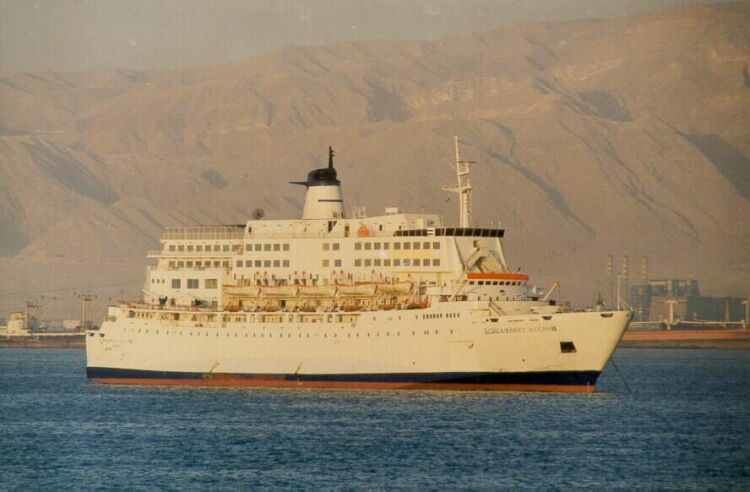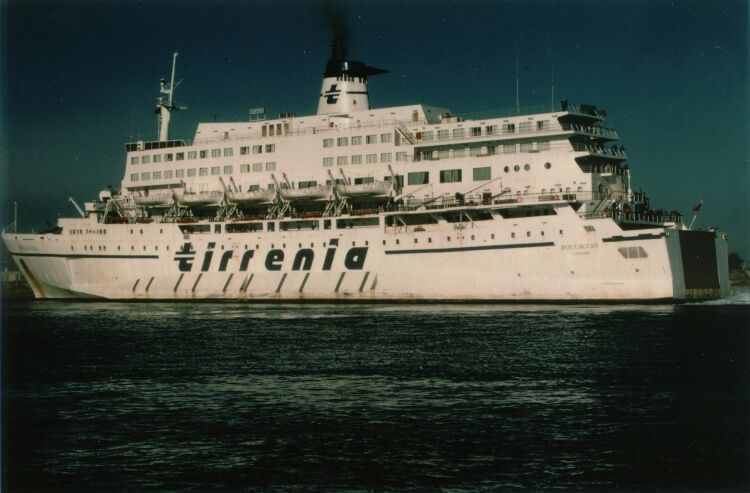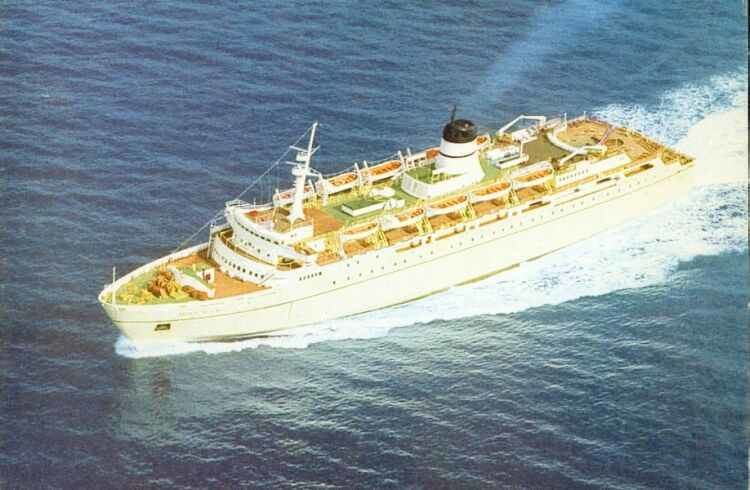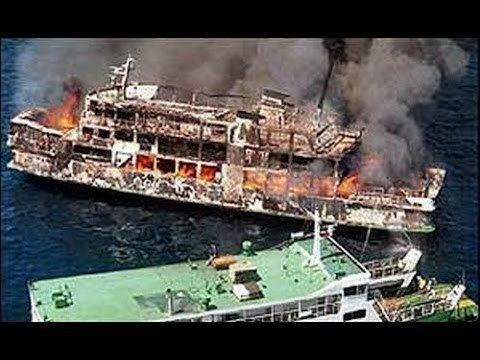Name Boccaccio Laid down 22 August 1968 [1] Refit 1991 Length 131 m Beam 24 m | Completed 30 June 1970 Launched 8 June 1969 Builder Fincantieri | |
 | ||
The MS al-Salam Boccaccio 98 was an Egyptian Ro/Ro passenger ferry, operated by El Salam Maritime Transport, that sank on 3 February 2006 in the Red Sea en route from Duba, Saudi Arabia, to Safaga in southern Egypt.
Contents
- Ship history
- The sinking
- Weather conditions
- Numbers on board
- Possible causes
- Search and rescue
- Similar incidents
- Trial of owners
- References

The ship was carrying about 1400 passengers and crew. The majority are thought to have been Egyptians working in Saudi Arabia, but they included pilgrims returning from the Hajj in Mecca. The ship was also carrying about 220 vehicles. No Mayday had been heard from the ship and poor weather conditions hampered the search and rescue operation. 388 people were rescued.

The immediate cause of the sinking appears to have been a build-up of sea-water in the hull, when the fire-fighters were trying to extinguish a fire in the engine-room. This was compounded by design faults inherent in Ro/Ro vessels, where minor flooding of the deck can gain rapid momentum (‘free surface effect’). When the captain asked permission to return to port, the ship’s owners ordered him to continue, despite knowing that there had been a fire. The owners were jailed in 2009 after their original acquittal was overturned.

Ship history

The vessel was built by the Italian company Italcantieri in 1970 with IMO number 6921282 and named Boccaccio at Monfalcone, Italy for Tirrenia di Navigazione. She was originally intended for Italian domestic service. Her dimensions were 130.99 m length overall with 23.60 m beam and 5.57 m draft. The main engines were rated at 16,560 kW for a maximum speed of 19 knots. The vessel had an original capacity of 200 automobiles and 1000 passengers. Five sister ships were built.

The vessel was rebuilt in 1991 by INMA at La Spezia, maintaining the same outer dimensions albeit with a higher superstructure, changing the draught to 5.90 m. At the same time her automobile capacity was increased to 320 and the passenger capacity was increased to 1,300. The most recent gross registered tonnage was 11,799.
Boccaccio was purchased in 1999 by El Salam Maritime Transport, headquartered in Cairo, the largest private shipping company in Egypt and the Middle East, and renamed al-Salam Boccaccio 98 (Arabic: عبارة السلام 98, Salam سلام means "peace"); the registered owner is Pacific Sunlight Marine Inc. of Panama. She is also referred to as Salam 98.
The sinking
Her last known position was 100 km (62 mi) from Duba, when she lost contact with the shore at about 22:00 EET (20:00 UTC). First reports of statements by survivors indicated that smoke from the engine room was followed by a fire which continued for some time. There were also reports of the ship listing soon after leaving port and that, after continuing for some hours, the list became severe and the ship capsized within 10 minutes as the crew fought the fire. In a BBC radio news broadcast an Egyptian ministerial spokesman said the fire had started in a storage area, was controlled, but started again. The significance of the fire was supported by statements attributed to crew members, who were reported to have claimed that "the firefighters essentially sank the ship when sea water they used to battle the fire collected in the hull because drainage pumps were not working."
Weather conditions
The Red Sea is known for its strong winds and tricky local currents. The region had been experiencing high winds and dust storms for several days at the time of the sinking. These winds may have contributed to the disaster and may have complicated rescue efforts.
The closest maritime weather report for 3 February 2006 00:00 UTC was from MV Glasgow Maersk, call sign MZGK7. Reporting from 27.00°N 34.40°E, approximately 150 km north-north-west of the sinking, the container ship shows winds of 24.1 kt (13 ms−1) from 320 degrees, with a surface pressure of 1005 hPa. Sea temperature was 25 °C and a significant wave height of only 45 cm. Visibility was good (10 km), with 7/8 cloud cover. There was also an active weather front overlying the area, clearly visible in METEOSAT imagery.
Numbers on board
The ship was carrying 1,312 passengers and 96 crew members, according to Mamdouh Ismail, head of al-Salaam Maritime Transport Company. Earlier an Egyptian official had mentioned 1,310 passengers and 105 crew (however, the Egyptian presidential spokesman mentioned 98 crew, while the Transport Minister said 104).
Possible causes
Several theories have been put forward about possible causes of the sinking.
Search and rescue
At 23:58 UTC on 2 February 2006 the air-sea rescue control room at RAF Kinloss in Scotland detected an automatic distress signal relayed by satellite from the ship's position. The alert was passed on via France to the Egyptian authorities.
On 3 February 2006 some lifeboats and bodies were seen in the water. At least 314 survivors and around 185 dead bodies were recovered. Reuters reported that "dozens" of bodies were floating in the Red Sea.
Rescue boats and helicopters searched the area, including four Egyptian frigates. Italian Coastal Patrol Unit Ships patrolled for more than 90 hours in severe weather conditions, and eight survivors were rescued by MFO vessels Vedetta and Sentinella. The United Kingdom diverted the warship HMS Bulwark which would have arrived in a day-and-a-half, but reports conflict as to whether or not the ship was recalled. Israeli sources report that an offer of search and rescue assistance from the Israeli Navy was declined. Egyptian authorities accepted a United States offer of a P-3 Orion maritime naval patrol aircraft after initially having said that the help was not needed.
Many survivors reported seeing the captain of the vessel being the first to leave the ship in a lifeboat [AP 2-04-06].
Similar incidents
Trial of owners
In July, 2008 the owner of al-Salam Boccaccio 98, Mamdouh Ismail, along with his son Amr Ismail and two others were acquitted of wrongdoing in connection with the disaster by an Egyptian court. An earlier parliamentary inquiry blamed Ismail's company for the disaster, saying they had operated the ferry despite serious defects. Also, the recovered data recorder proved that the ferry's owner knew there had been a fire on board but gave orders to continue on instead of returning to port as the captain had requested. Family member of the victims felt the ruling was brought about by corruption. Ismail is a member of Egypt's upper house and is very well connected.
On 11 March 2009, after the initial acquittal was overturned in a hearing presided over by Judge Khaled Badereldin, Mamdouh Ismail was sentenced to seven years in prison. Two other employees of the company were sentenced to three years in prison each.
